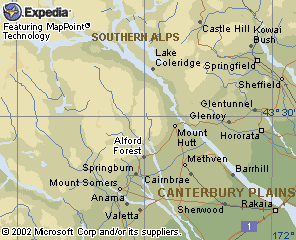
Although there were many that doubted the existence of diamonds, including the Founding Director of the Canterbury Museum, geologist and writer, Sir Julius von Haast, Isaac took some convincing. He sent the diamonds to experts in London, New York and Amsterdam for testing, and on a favourable report from London, started up a limited liability company with capital of £100 in £1 shares. Two other companies, the Pioneer Diamond Company and the Kohinoor Company were formed quickly, and later more companies - the Oriental, Caledonian, Albion, Regent and Canterbury. Plans for a township were drawn up, and several hundred acres of Andrew McFarlanes' homestead block were subdivided and sold in quarter-acre sections. A hotel was built, with a large cellar for ales. Mining licences were granted to one penny an acre for six months. Prospectors and speculators crowded into Alford Forest.
On April 9, a reporter from the Lyttelton Times visited the site workings, and spent some time talking with the men. "Mr Jacobsen is confident that for eleven miles there is every probability (he says certainty) of diamonds being discovered. His idea is that, whereas the Cape field [Cape Town, South Africa] is only a deposit, remote from some grand centre of volcanic eruption, this is an actual source or matrix, and should expectations be realised, great things may be looked for from the whole length of the river bed, but the nearer the matrix the greater the chances are of decided success." Isaac confirmed that "I am certain that within a week we shall have startling disclosures to announce. I do not want to keep anything secret. My desire is to do good; and all that is required is not so much capital as energy and perseverance."
Soon the excitement of the New Zealand find reached Mark Herman, from Cape Town. On arrival, he was surrounded by people eager to show him the stones - his response - they were not diamonds. Jacobsen took offence, and declared that Herman knew nothing about diamonds. Soon after, a telegram from London confirmed that the stones were crystals. This spelt the beginning of the end. Prospectors did not renew their licences, companies wound up their affairs. The final blow came when a parcel of genuine South African diamonds were sent out to New Zealand, and compared with those of Alford Forest. There was no mistaking the difference.
As for Diamond Town, no house was ever built. The land was eventually used for plantings of trees for milling.